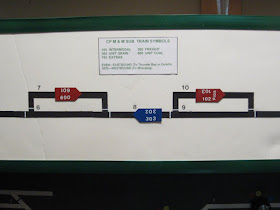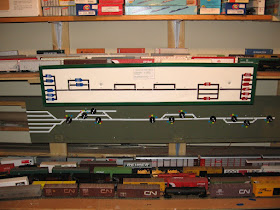 The dispatcher's panel on the M & M. Sub. The board
below the panel controls power to the blocks; the
panel itself shows train locations.
The dispatcher's panel on the M & M. Sub. The board
below the panel controls power to the blocks; the
panel itself shows train locations.
Sometimes inspiration comes from the most unexpected places. In the case of the dispatcher’s panel for my CP Rail Manitoba & Minnesota Subdivision, it came from the fridge door.
My double-deck railway is operated by conventional DC control. The dispatcher, who controls the blocks for the mainline trackage, is located in a small room off the main layout room (the same room that holds the staging yards).
Since my layout is “dark” (unsignalled), the dispatcher gives engineers clearance by radio to move from block to block. I needed a way for him to know where each train was located, what train it was and what direction it was travelling.
Since I always want to do things as simply as possible, I sought a low-tech (e.g. cheap) solution to this challenge. That’s where the fridge door came in. If yours is anything like mine, you have all sorts of things stuck on it with magnets. Many of these are the thin magnets that come free in the mail from businesses or charities.
I was looking at the door one day when I realized they not only do they stick to metal—they stick to each other. At that moment, an idea was born.
 Close up of the panel, showing train numbers. The numbers
correspond to the electrical blocks, controlled by the
board below.
Close up of the panel, showing train numbers. The numbers
correspond to the electrical blocks, controlled by the
board below.
Here’s how it works.
I began the project by collecting as many thin magnets as I could. I got them at conventions, trade shows, from realtors (who send them through the mail), at the local baseball stadium (the team prints its schedule on a large fridge magnet), businesses and stores.
Once I had enough magnets, I cut a piece of Masonite the appropriate width and length (in my case, 34 inches long by seven inches high). I glued a piece of white foam core to it, then drew on it a schematic of my track plan. (You could also just paint it white.)
Next, I used a hobby knife to cut the biggest magnets into ¼ inch wide strips. I then glued them to the foam core with contact cement, following the track schematic I had drawn on it earlier.
 To make the panel, you cut the magnet (below) into
strips and tags.
To make the panel, you cut the magnet (below) into
strips and tags.
The last step was to give the panel a finished look by adding some plastic angle from the local home hardware store (the kind used to protect the corners of walls). I spray painted them with primer, then sprayed on a coat of green paint. Since the strips are self-adhering, I simply peeled off the protective paper and pressed them on to the panel.
Next, I made the train tags. Using a hobby knife, I cut magnets into rectangles roughly one inch long by ½ inch wide. Aftere that, I cut triangles out of one end to make them pointed. I then gave them a spray coat of primer on the advertising side. When dry, I spray painted them red or blue. When that coat was dry, I added the train numbers with CDS dry transfers—even numbers are eastbound, odd numbers go west.
Operations
Prior to a new operating session, I make sure the train tags line up with the trains in the staging yards or on the layout. As the dispatcher gives a train clearance from one town to another, he lifts the tag off one block and moves it to another—the tags and lines, being magnetic, stick to each other. Once a train reaches the end of the line (the opposite staging yard), the tag is flipped and it is ready to follow the train back to where it came from.
That's it; easy and cheap, and very (almost embarrassingly) low-tech. But, it works, and that's always good enough for me.
 Overview of the panel. That's Winnipeg staging on
the top, Thunder Bay/Duluth staging on the bottom. The
helix is located behind the two panels.
Overview of the panel. That's Winnipeg staging on
the top, Thunder Bay/Duluth staging on the bottom. The
helix is located behind the two panels.


















































